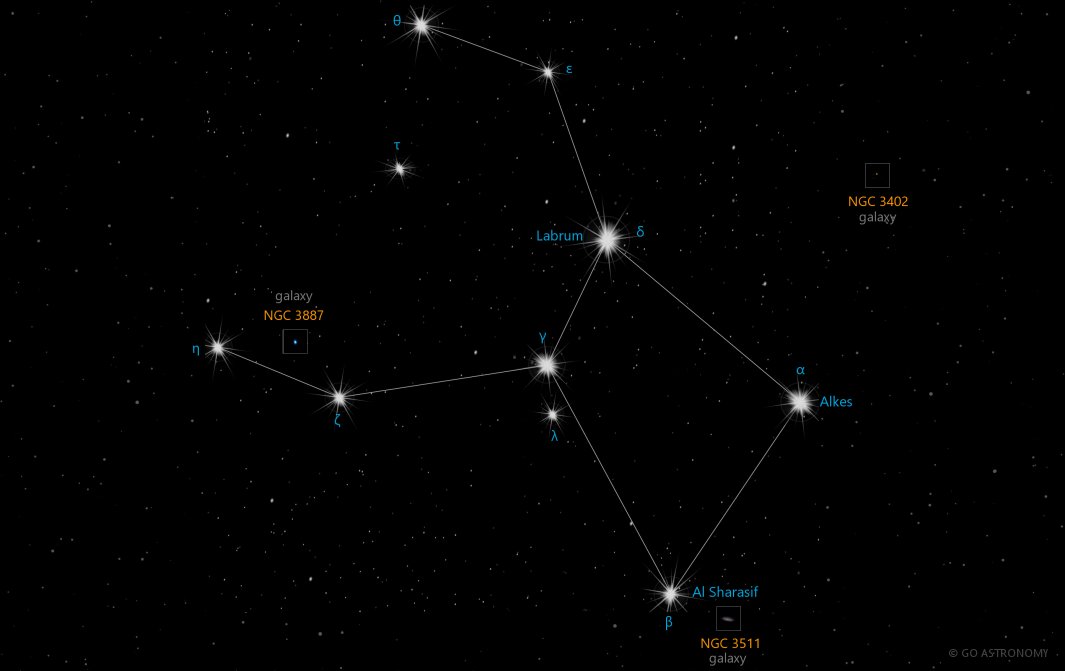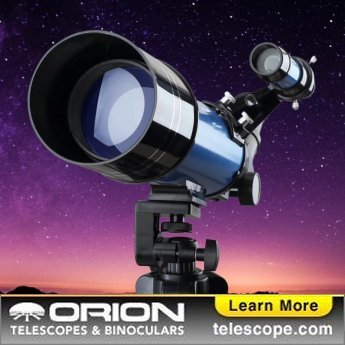Crater, the Cup (Crt)
(CRAY-ter)
The Southern constellation of Crater, the Cup, is best viewed in Spring during the month of April.
Crater is the 53rd largest constellation. It's brightest star is Labrum at magnitude 3.57. The boundary of the Crater constellation contains 10 stars that host known exoplanets.
- Pronunciation:
- CRAY-ter
- Meaning:
- Cup
- Genitive:
- Crateris
- Abbreviation:
- Crt
- Constellation Family:
- Hercules
- Hemisphere:
- Southern
- Quadrant:
- SQ2
- Visibility:
- 65° N - 90° S
- Best viewing month*:
- April
- Area:
- 282 sq. degrees
- Size:
- 53rd largest
- Right Ascension (avg):
- 11h 21m
- Declination (avg):
- -15°
- Brightest star:
- Labrum (3.57)
- Stars with planets:
- 10
- Messier objects:
- |
- Caldwell objects:
- |
Brightest Stars in Crater
The 10 brightest stars in the constellation Crater by magnitude.
- Star
- Magnitude
- Spectral class
- Delta Crateris (δ Crt)
- 3.56
- K0III
- Gamma Crateris (γ Crt)
- 4.06
- A9V
- Alpha Crateris (α Crt)
- 4.08
- K1III
- Beta Crateris (β Crt)
- 4.46
- A1V
- Theta Crateris (θ Crt)
- 4.7
- B9.5Vn
- Zeta Crateris (ζ Crt)
- 4.71
- G8III
- Epsilon Crateris (ε Crt)
- 4.81
- K5III
- Lambda Crateris (λ Crt)
- 5.08
- F3IV
- Eta Crateris (η Crt)
- 5.17
- A0V
- Iota Crateris (ι Crt)
- 5.48
- F7V
Galaxies in Crater
The most notable galaxies in the constellation Crater. Also see all galaxies.
Milky Way Satellites in Crater
Dwarf satellite galaxies that orbit the Milky Way Galaxy located in the constellation Crater. Also see all Milky Way satellite galaxies.
- Galaxy name
- Alt name
- Magnitude
- Crater II
The Celestial Cup
Crater, which translates to "the cup" in Latin, is a constellation located in the Southern Hemisphere's celestial sphere. It is a relatively faint constellation, with no star brighter than the fourth magnitude, yet its unique mythology and interesting celestial objects make it a point of intrigue for stargazers and astronomers.
Historical Background
The constellation Crater is steeped in mythology. In Greek legend, it is said to represent the cup of the god Apollo, a symbol of divine wrath and the dispensing of justice. In other narratives, it is linked to the tale of Corvus, the crow, who Apollo dispatched to fetch water but returned late, having waited for a fig to ripen. The cup represents the water container from which the crow should have fetched water.
Location and Main Features
Crater is situated in the second quadrant of the Southern Hemisphere (SQ2) and can be observed at latitudes between +65? and -90?. It is bordered by several constellations, including Leo, Hydra, Virgo, Corvus, and Sextans.
Despite its faintness, Crater hosts a handful of significant stars. The brightest star, Delta Crateris, is a white A-type main sequence dwarf and has an apparent magnitude of 3.56. Beta Crateris, also known as Alkes from the Arabic term for 'the cup', is the second brightest star with a magnitude of 4.07 and is a K-type giant approximately 196 light-years distant.
Deep Sky Objects
Amongst the deep-sky objects within Crater's boundaries, one of the most interesting is the spiral galaxy NGC 3887. With an apparent magnitude of 11.1, it is located about 60 million light-years away and can be viewed with larger backyard telescopes under dark skies.
Another remarkable galaxy, NGC 3981, is a spiral galaxy with an apparent magnitude of 11.9. It's notable for its extended spiral arms and a distorted shape, likely caused by gravitational interaction with other galaxies.
Observation
For observers in the Northern Hemisphere, Crater is visible in the southern sky in the evening from February through June. The best time to observe Crater is during the month of April when the constellation is at its highest point.
Because Crater is relatively faint, it's helpful to use the brighter constellations around it for guidance. The constellation Corvus, the crow, is located to the east of Crater and contains stars of a similar brightness. The constellation Virgo, containing the bright star Spica, is located to the north of Crater and can be used as a reference point.
While Crater's stars are faint and best viewed with a telescope, the constellation can be appreciated for its rich mythological significance and its unique place among the stars. Regardless of one's equipment, observing Crater can be a rewarding experience for those who appreciate the less conspicuous wonders of the night sky.
* Constellation shown for northen hemisphere skies. For the southern hemisphere, constellations appear rotated 180 degrees (upside-down and left-right reversed) from what is shown. Remember that seasons are reversed too - summer in northern latitudes is winter in southern latitudes.
** Circumpolar constellations are visible year-round in the hemisphere listed (and not at all in the opposite hemisphere).





